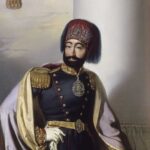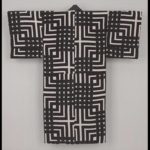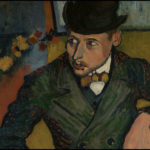1770-1779
1770s fashion simplified the earlier decades styles for both womenswear and menswear, leading to new fashions that exemplified the ‘casual’ aesthetic that had taken hold.
Read MoreThe 1760s mark the last decade during which the robe à la française dominated women’s wardrobes since it was first introduced in the 1720s. In the last three decades of the eighteenth century, other, more informal styles became fashionable for daywear and the robe à la française was increasingly worn for evening. For men, the distinction between the subdued informality of Englishmen’s dress and the colorful formality of Continental styles (particularly those of France and Italy) remained pronounced, although this would change in the following decades in favor of the former. The narrowing of the coat that began around 1750 continued in this decade and a low standing collar that would increase in height until the end of the century appeared in the middle years.
Read MoreThe mid-eighteenth century marked the height of rococo influence on women’s dress; colorful floral-patterned silk gowns and matching petticoats with three-dimensional trimmings, often applied in serpentine bands, were shown to advantage over wide panniers. During this and the following three decades, the marchande de modes, or milliner, who supplied and artfully arranged these delicate decorations became increasingly important in the creation of a fashionable gown. The coats of men’s three-piece suits became slimmer, losing the extreme side fullness of the 1730s and 1740s, and the waistcoat shortened to mid-thigh. Although wool was favored for daywear, especially among Englishmen, silks and velvets that might be embellished with embroidery or metallic galloon or lace were still obligatory for formal wear.
Read MoreBeetle-wing embroidery: a colonialist fantasia and exotic fad in nineteenth-century England and...
Read MoreBetween the fifth century and tenth century, the Coclé people inhabited an archaeological area in Central America known as Gran Coclé, which coincides with the modern-day Panamanian province of Coclé. A remarkable necropolis titled Sitio Conte there contains many precious objects that express social status, political power, and religious beliefs, while also demonstrating expert metal-smithing in the luxurious ornamentation of rulers and depictions of gods.
Read MoreStreamlined in shape like other 1930s gowns, the Tears dress features surrealist elements that make it emblematic of the design collaboration between Elsa Schiaparelli and artist Salvador Dalí.
Read MoreRaffia cloth is a type of textile woven from palm leaves and used for garments, bags and mats.
Read MoreCharles James’ 1955 “Butterfly” gown features a body-conscious sculpted sheath and large bustle skirt, which is reminiscent of the tightly fitted bustle dresses of the early 1880s.
Read MoreSince the mid-20th century, relations between Africa and China have grown stronger leading to a significant change in the mutual adaptation of fashion between both nations. A 21st century, Sino-African style has been formed by the intercultural meshing of traditional garments, textiles, and motifs.
Read More The Fez and the Ottoman Path to Modernity
The Fez and the Ottoman Path to Modernity 1869 – Red Silk Dress
1869 – Red Silk Dress katazome (stencil printing)
katazome (stencil printing) 1905 – André Derain, Lucien Gilbert
1905 – André Derain, Lucien Gilbert